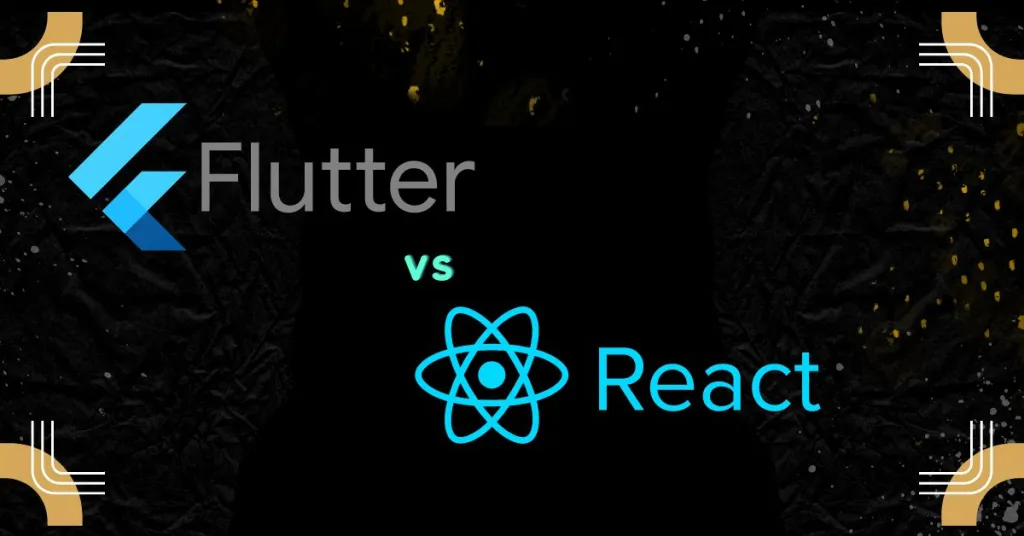Flutter vs React Native: A Comparison of Two Popular Cross-Platform Frameworks

If you are looking for a way to create mobile apps that run on both iOS and Android devices, you might have heard of Flutter and React Native. These are two of the most popular cross-platform frameworks available today, and they are both backed by tech giants: Google and Facebook, respectively.
But what are the advantages and disadvantages of choosing one technology over the other? Which one has more demand right now? What companies are using each technology? What companies are behind those technologies? What reason should a project manager have to pick Flutter over React Native? What labor is easier to hire and what is the average hourly rate for a freelancer and small business to create a project using those technologies?
In this article, we will try to answer these questions by comparing Flutter and React Native in terms of performance, developer experience, ecosystem, device compatibility, and more. Let’s get started!
What is Flutter?
Flutter is a cross-platform UI framework developed by Google. First released in May 2017, Flutter has grown steadily in popularity over the years. One of Flutter’s main selling points is that it enables you to create cross-platform applications using a single codebase.
Traditionally, a company would need multiple tools and developers to create an application that was available on the web, mobile, and desktop. For example, you might need:
- A developer who specializes in web development using React to build the website
- Another developer using C# and Java to create the desktop version.
- A dedicated mobile developer using Kotlin and Swift to build the Android and iOS apps
This approach would require a whole team of developers, not to mention a ton of meetings to make sure the design and branding are consistent across all platforms. You also have to factor in testing for each platform and addressing their respective bugs and quirks.
With Flutter, companies can hire one developer to create apps across platforms with just one codebase to manage. This significantly reduces the time and resources required to launch and maintain an application.
Flutter 3 introduced fairly substantial changes. While the API for writing mobile and web applications hasn’t changed much, you can now use the same codebase to create iPhone, Android, Web, Windows, Mac, and Linux applications using the Flutter Compiler. In addition, Flutter 3 provides better support for Firebase along with a Casual Games Toolkit for creating games with Flutter.
What is React Native?
React Native is another cross-platform framework that allows you to build native-like mobile apps using JavaScript and React. It was created by Facebook in 2015 as an open-source project based on their internal framework for developing mobile apps.
React Native works by using a JavaScript bridge to communicate with native modules that provide access to native features such as camera, location, sensors, etc. This way, you can write your app logic in JavaScript and use native UI components for rendering.
React Native also supports hot reloading and live reloading, which means you can see the changes in your app without rebuilding or restarting it. This makes development faster and more convenient.
React Native has a large and active community of developers who contribute to its core library and create third-party libraries for various functionalities. You can find many resources online to learn React Native or solve any issues you might encounter.
Some of the well-known apps built with React Native include Facebook, Instagram, Skype, Pinterest, Uber Eats, Discord, and Walmart.
Key Differences Between Flutter and React Native
Flutter and React Native share a lot of similarities, but they are also quite different in a handful of keyways. Here are some of the main differences between them:
- Programming language: Flutter uses Dart as its programming language, while React Native uses JavaScript (or TypeScript). Dart is a compiled language that supports both object-oriented and functional paradigms. It also has features such as null safety, generics, mixings, extension methods, etc. JavaScript is an interpreted language that follows a prototype-based inheritance model. It is widely used for web development and has many frameworks and libraries available.
- UI components: Flutter uses its own set of widgets for creating UI elements, while React Native uses native UI components for each platform. Flutter widgets are highly customizable and can adapt to different screen sizes and orientations. They also provide a consistent look and feel across platforms. React Native UI components are more platform-specific and follow the native design guidelines. They also offer better performance and accessibility than Flutter widgets.
- State management: Flutter provides several options for managing state in your app, such as setState(), Provider, Bloc, Riverpod, etc. React Native relies on external libraries for state management, such as Redux, MobX, Recoil, etc. State management is an important aspect of app development that affects how data flows between components and how the app reacts to user actions or external events.
- Documentation: Both Flutter and React Native have extensive documentation that covers the basics and advanced topics of their frameworks. However, Flutter’s documentation is more organized and comprehensive than React Native’s. Flutter’s documentation also includes tutorials, code samples, videos, cookbooks, etc. React Native’s documentation is more scattered and sometimes outdated or incomplete.
- Testing: Flutter has a built-in testing framework that supports unit testing, widget testing, and integration testing. You can also use other tools such as Mockito, Flutter Driver, etc. for mocking and automation. React Native does not have a built-in testing framework, but you can use third-party tools such as Jest, Enzyme, Detox, etc. to test your app. Testing is a crucial part of app development that ensures the quality and reliability of your app.
Flutter vs React Native: Performance
One of the most important factors to consider when choosing a cross-platform framework is performance. How fast and smooth is your app on different devices and platforms? How much memory and CPU does it consume? How does it handle complex animations and transitions?
Performance is often influenced by many factors, such as the programming language, the UI rendering engine, the native bridge, the app architecture, the optimization techniques, etc. Therefore, it is hard to make a general comparison between Flutter and React Native in terms of performance without considering the specific context and use case.
However, based on some common benchmarks and anecdotal evidence, we can say that Flutter has an edge over React Native in performance. Here are some of the reasons why:
- Flutter compiles its Dart code into native code using ahead-of-time (AOT) compilation, which means it runs faster and more efficiently than JavaScript code that is interpreted at runtime.
- Flutter uses its own rendering engine called Skia, which draws everything on a canvas using GPU acceleration. This allows Flutter to achieve high frame rates and smooth animations without relying on native UI components.
- Flutter does not use a JavaScript bridge to communicate with native modules, which means it avoids the overhead and latency of serialization and deserialization of data. Instead, it uses platform channels that are more direct and efficient.
- Flutter supports stateful hot reload and hot restart, which means you can change your code and see the results instantly without losing the app state or restarting the app. This makes development faster and more productive.
React Native, on the other hand, has some performance drawbacks compared to Flutter. Here are some of them:
- React Native runs its JavaScript code on a separate thread using a JavaScript engine such as Hermes or JSCore. This means it has to deal with the performance limitations and inconsistencies of different JavaScript engines on different platforms.
- React Native uses native UI components for rendering, which means it has to synchronize the state of the JavaScript code with the native UI elements using a JavaScript bridge. This can cause performance issues such as jankiness, lagging, or dropped frames when dealing with complex UIs or animations.
- React Native does not support stateful hot reload or hot restart, which means you have to rebuild or restart your app every time you make a change in your code. This can slow down your development process and affect your productivity.
Of course, this does not mean that React Native apps are always slow or unresponsive. There are many ways to optimize your React Native app for better performance, such as using Hermes engine, enabling ProGuard or R8, using FlatList or SectionList instead of ScrollView, using PureComponent or memo for avoiding unnecessary re-rendering, using requestAnimationFrame for animations, etc.
However, these optimizations often require extra work and knowledge from the developer. With Flutter, you get better performance out of the box without much effort.
Flutter vs React Native: Developer Experience
Another factor to consider when choosing a cross-platform framework is developer experience. How easy and enjoyable is it to develop an app using Flutter or React Native? How steep is the learning curve? How much support and resources are available?
Developer experience is subjective and depends on personal preferences and backgrounds. Some developers might prefer one framework over another based on their familiarity with the programming language, the IDE, the tools, etc.
However, based on some common criteria and feedback from developers who have used both frameworks, we can say that Flutter offers a better developer experience than React Native. Here are some of the reasons why:
- Flutter has a lower learning curve than React Native for beginners. If you are new to mobile app development or cross-platform frameworks, you might find Flutter easier to learn than React Native. This is because Flutter has a more consistent and coherent API that follows a declarative approach for creating UIs. You don’t have to deal with multiple concepts such as JSX syntax, props, state, hooks, lifecycle methods, etc. that are common in React Native.
- Flutter has better tooling support than React Native for development. If you use an IDE such as Visual Studio Code or Android Studio for developing your app, you will find that Flutter has better integration and features than React Native. For example, you can use hot reload and hot restart to see your changes instantly without losing state or restarting your app. You can also use Flutter’s DevTools for performance profiling, network inspection, debugging, layout inspection, etc. Flutter’s command-line interface (CLI) also provides useful commands for building, testing, and deploying your app.
- Flutter provides better code organization and architecture than React Native. With Flutter, you can use packages such as Provider, Riverpod, Bloc, etc. to structure your app in a clean and scalable way. You can also use null safety to catch potential bugs at compile-time and write more robust code. React Native relies more on third-party libraries and conventions for managing state, routing, validation, etc., which can be more fragmented and inconsistent.
- Flutter provides more customization and flexibility than React Native for UI design. If you want to create a custom look and feel for your app that goes beyond the native design guidelines, you will find Flutter’s widgets and themes more versatile and powerful than React Native’s components. You can also create custom animations, transitions, gestures, etc. in Flutter using the rich set of APIs and libraries available.
React Native also has its advantages in developer experience, such as the familiarity with JavaScript, the large community of developers, the wide range of third-party libraries, etc. However, React Native also has some challenges and frustrations, such as dependency issues, breaking changes, compatibility problems, outdated documentation, etc. that can affect your development process and productivity.
If you are already comfortable with JavaScript and React, you might find React Native easier to work with than Flutter. If you are new to cross-platform development or looking for a more streamlined and integrated experience, you might prefer Flutter.
Flutter vs React Native: Ecosystem
Both Flutter and React Native have large and vibrant ecosystems that provide a wide range of tools, libraries, plugins, templates, etc. for extending and enhancing your app. However, there are some differences between them that can affect your choice:
- React Native has a larger and more mature ecosystem than Flutter. Since React Native has been around longer and has a larger user base, you can find more third-party libraries and community support for React Native than Flutter. If you need a specific functionality or integration that is not available in the core framework, you are more likely to find it in React Native’s ecosystem.
- Flutter’s ecosystem is growing rapidly and catching up with React Native’s. Despite being newer, Flutter has attracted a lot of attention and contributions from developers and companies around the world. Google is also investing heavily in Flutter and promoting it as the future of app development. This means that Flutter’s ecosystem is expanding and improving quickly, with new packages and updates being released regularly.
Flutter’s ecosystem is more cohesive and consistent than React Native’s. Since Flutter controls the entire rendering pipeline and provides a unified set of APIs and conventions, you can expect a more consistent and seamless experience when using third-party libraries or plugins in Flutter. React Native’s ecosystem is more fragmented and varied, with different libraries following different standards and practices.
Flutter vs React Native: Device Compatibility
When it comes to device compatibility, both Flutter and React Native provide good support for iOS and Android devices. However, there are some differences between them that can affect your choice:
– Flutter provides better support for newer and less common devices and platforms. Since Flutter uses its own rendering engine and does not rely on native UI components, it can support a wider range of devices and form factors, such as foldable phones, wearables, TVs, etc. Flutter also supports desktop and web development, which means you can use the same codebase for building apps on Windows, macOS, Linux, and the web.
– React Native focuses more on providing a native-like experience on iOS and Android devices. If you want your app to follow the native design guidelines and behavior of each platform, you might prefer React Native. React Native also has community support for other platforms such as Windows and macOS, but it is less comprehensive and official than Flutter’s support.
Flutter vs React Native: Hiring and Cost
If you are a project manager or a business owner, you might be concerned about the availability and cost of developers for Flutter and React Native.
– React Native developers are generally easier to find and hire than Flutter developers. Since React Native uses JavaScript and React, which are widely used and taught languages and frameworks, you can find more developers with experience and expertise in React Native. Flutter developers might be less common and more specialized, especially if they have experience with Dart, which is less popular and familiar than JavaScript.
– The average hourly rate for a React Native developer might be slightly lower than a Flutter developer, especially in regions where JavaScript and React are more prevalent. However, the cost difference might not be significant, and it can vary depending on other factors such as the developer’s experience, location, portfolio, etc.
Conclusion
Choosing between Flutter and React Native depends on your specific needs, preferences, and constraints. Both frameworks have their strengths and weaknesses, and both are capable of building high-quality cross-platform apps.
- If you prioritize performance, customization, developer experience, and future growth, you might prefer Flutter.
- If you prioritize community support, native-like experience, existing knowledge of JavaScript, and React, you might prefer React Native.
It’s always a good idea to try both frameworks, consult with experienced developers, and consider your project requirements before making a final decision. You might also consider other factors such as your team’s skillset, your target audience, your budget, your timeline, etc. that are unique to your situation.
In the end, both Flutter and React Native are powerful tools that have proven successful in the industry, and either choice can lead to a successful mobile app development project.


